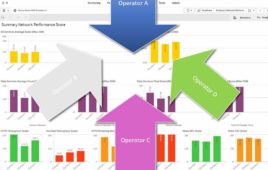The tussles and the twists between AT&T and the US government to wrestle control of Time Warner is almost reminiscent of the power brokering and conflicts that take place on the Game of Thrones. Keeping it within the context of Game of Thrones, think of each player in this battle – AT&T, Time Warner, the US government, Netflix and the other warring factions – as the houses fighting for control over the Iron Throne. What does the Iron Throne represent? Content and data. Zettabytes of it. And Time Warner/HBO’s Game of Thrones is hot property.
That is hardly surprising given that HBO’s hit series set a record with a whopping 16 million Americans watching the season 7 premier and it was aired across 186 countries – often at the same time. Just imagine the potential from all that user data generated.
In fact, Americans are said to ‘engage’ or touch their phones around 2,600 times per day to check their handset. So, apart from the OTTs, what other businesses have access to vast amounts of user data? Mobile operators of course. But, there’s a catch.
Content is the name of the game
Mobile operators have struggled to harvest the rich user data residing on their networks. There are a number of reasons for this. First and foremost, operators have to focus on network reliability – and rightly so. Research has shown that subscribers blame their wireless network provider if a video buffers for as little as 6 seconds.
Another challenge for carriers has been the legacy technology that they have accumulated over time. This has contributed to data silos spread across the network and it has stifled many mobile operators.
Contrast that with the relatively “new” businesses of OTTs such as Netflix, who have been in existence for a much shorter time. Their mindset is focused solely on content. Networks, for all their reliability and legacy, are viewed purely as delivery mechanisms. They take an aggressive approach to data analytics and content is the name of their game to grow users and launch new services.
Forward looking mobile operators such as AT&T understand the value of content and associated data. That is why it is prepared to pay an eye watering $85 billion for Time Warner and fight hard to secure the deal. AT&T Chairman and CEO Randall Stephenson, appearing on CNBC recently, made it very clear that the deal with Time Warner is aimed at competing with Netflix and Amazon.
Critical mobile video analytics
Imagine having access to all this data, not only about customer behavior when it comes to content but also using this rich data to make decisions on Mobile Video Quality of Experience (QoE). This can be done by analyzing services such as Netflix vs HBO and the location of users when they watch video applications. Data would also reveal performance and what percentage of Netflix vs Amazon vs HBO content was in HD/4K (high resolution). What level of HD/SD content do subscribers consume the most, at what time of day from what location (anonymized and aggregated data to preserve user privacy)? Needless to say, the possibilities with data is endless. Getting at the data is the issue.
If mobile operators are serious about driving revenues and taking on the OTTs, they need to unlock the data siloed away in applications. Currently, that’s easier said than done as conventional subscriber data management tools are unable to access data on siloes without making changes to the network. And the much anticipated 5G poses yet another conundrum for operators.
5G stateless battlefield – Unified Data Layer
The good news with 5G is that it will connect billions of devices and provide lightning fast connectivity. 3GPP has defined a unified data layer in their standards definition for 5G to ensure that data for all the devices does not get locked up or lost in individual application silos. So in essence, operators require a unified data layer, a cloud database that is capable of storing diverse data sets like fast changing user session data to long-term subscription data. This unified data layer will deliver reliable data consistency, resilience of network functions, faster recovery from failures and enable the secure sharing of network data. Ultimately, a cloud database leads to efficiency and better data analytics.
Data is the new oil and the clue lies in 5G
So the billion dollar question is – can the likes of AT&T, leverage their 5G network with unfettered access to data across all their applications, couple that with their potential new asset in HBO content, give Facebook, Netflix, Amazon a run for their money? Are operators willing to mandate that all applications comply with the 5G stateless mantra which means that all network and user data is unlocked from the individual applications and managed in the Unified Data Layer? The OTTs have long figured out that data is the new oil that has contributed hundreds of billions to their market caps (Netflix has about $140B of market CAP today while AT&T with a much higher annual revenue is only about $55B more in market CAP obviously at a much lower multiple). The operators have woken up to that reality and are now aiming to give them a run for their money.
The battle for data is just getting started.




